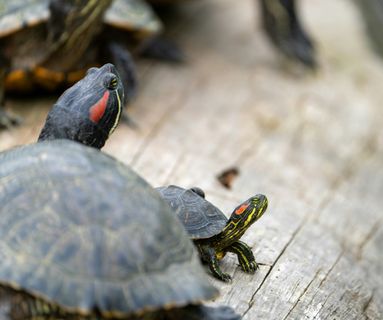
Red-Eared Slider
Trachemys scripta elegans
Adult Size: average 6-8 inches, with some specimens getting as large as 16 inches.
Lifespan: average 20-30 years, rarely up to 70 years.
Red-eared sliders are a subspecies of pond sliders native to the Midwestern United States and Mexico. However, this very invasive species is now found on every continent except Antarctica due to numbers of pets being released into native waterways worldwide and it’s considered one of the world’s 100 most invasive species. Often abandoned by owners not prepared for a large aquatic turtle when initially purchased from illegal roadside vendors as tiny hatchlings, this extremely hardy species is able to colonize any body of water that stays above freezing. Commercial breeding farms produce thousands of hatchlings and juvenile turtles annually for the pet trade. Unfortunately, these artificial ponds tend to be overcrowded and disease and mortality rates are high. Hatchlings usually die within a few months of purchase, often secondary to inadequate housing and nutrition as roadside vendors often mislead prospective buyers on the difficulty of turtle ownership. Even with this high mortality rate, enough survive to adulthood to continue to add to the overpopulation issue. Anyone interested in this species is encouraged to do thorough research and then adopt a turtle from one of the numerous rescues housing homeless animals throughout the country in light of purchasing a hatchling.
It’s not uncommon for breeding farms to be heavily contaminated with pathogenic organisms, such as Salmonella, which contributes to the association of baby turtles with human illness. Infected turtles will be asymptomatic while serving as a health risk to young children and immunocompromised individuals. Due to this, the FDA outlawed the sale of turtle eggs or turtles less than 4 inches in carapace length in 1975, as small turtles fit perfectly inside the mouth of a child. Many stores today circumvent this law by offering hatchlings for sale for “scientific, educational, or exhibition purposes.”
These turtles are known for inhabiting waterways in large numbers and can often be seen basking one on top of the other basking on logs and partially submerged rocks. Fairly powerful swimmers, they can handle deeper lakes and rivers with ease. Adults are sexually dimorphic, with males sporting long front claws they use for courtship.
Indoors: Large aquarium where the water depth is at MINIMUM as deep as the turtle is wide and allows enough space for swimming. For most adult turtles this results in 75-100 gallons PER turtle.
Outdoors: Red-eared sliders, like most aquatic turtles, are best housed outdoors in a pond of at least 300 gallons or more.
Substrates, such as sand or gravel, are best avoided as turtles often accidentally (or intentionally) consume these and end up with blockages of their digestive systems.
Indoors: Water temperatures should be maintained with a turtle-safe water heater between 75-85 degrees F. A basking platform should also be provided with a heat lamp allowing a bask spot of 85-95 degrees F.
Turtles require UVB lighting to process calcium properly. UVB lighting should be provided using either fluorescent (tube or "spiral" bulbs) or mercury vapor bulbs designed specifically for use in reptiles. When selecting fluorescent bulbs the high-output 10.0 bulbs are recommended as tortoises require fairly high levels of UVB exposure. It should be noted that these bulbs will stop providing UVB long before they stop producing visible light so they will need to be changed regularly, usually every 6 to 12 months depending on the manufacturer's recommendations.
These aquatic turtles should be fed directly in water with a diet based on a high-quality turtle pellet, such as Zoo Med or Mazuri. We do not recommend Tetra’s ReptiMin or Wardley’s brand pellets as these often are implicated with nutritional disorders. Along with pellets offer a variety of live or frozen freshwater fish, earthworms, and mealworms. Aquatic plants such as water lettuce is also enjoyed as well as leafy grocery store greens such as romaine lettuce or collard greens. Feed turtles daily to every 3 days, while turtles will gladly consume more this leads to obesity as well as poor water quality.
Provide areas for turtles to bask as well as submerged rocks and logs. Live aquatic plants are also appreciated, but keep in mind these may be snacked on by the turtle.
The water should be filtered using a fish tank or pond filter. Turtles are messier pets than fish so it’s best to choose a filter rated as least twice as big as the volume of water in the enclosure. Perform a 30-50% water change every month or more as needed. Monitor water quality using fish testing kits, test-tube based kits tend to be more accurate.
Copyright © All Rights Reserved
